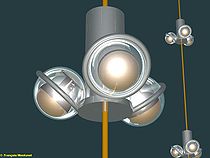Antares (neutrino telescope)
The ANTARES neutrino telescope is a large submarine instrument for the detection of neutrinos of cosmic origin. It is located in the Mediterranean Sea at a depth of around 2500 m, 30 km off the coast of Toulon (southern France). It is created and operated by a consortium of institutes, universities and research institutions from France , Germany , Italy , Russia and Spain . The research areas involved are astrophysics and astronomy , geophysics and oceanography . Antares, also the name of a star, is an acronym for A stronomy with a N eutrino T elescope and A byss environmental RES earch. The neutrino telescope has been fully operational since 2008.
Structure and functionality
Neutrinos are electrically neutral, practically massless and only react with matter through weak interaction . It is therefore difficult to prove it. In the Antares experiment, they are detected using Cherenkov radiation , which generates the charged reaction products of the neutrinos in the water, similar to the IceCube detector. In order to produce a sufficient number of particle signals for statistically significant statements, the detector volume must be large and data must be collected for years. The Antares detector covers an area of 10 hectares on the ocean floor and has a volume of around 1 cubic kilometer. The optical detector elements (modules) are anchored on 450 m long vertical chains ( strings ) on the sea floor, which is around 2400 m deep south of the island of Porquerolles . The cables arrive at La Seyne-sur-Mer on the coast. The signals are evaluated there at the Michel Pacha Institute.
We are interested in those neutrinos that come through the earth from the southern celestial sphere. The reaction product from a neutrino burst - usually a muon - continues the path of the neutrino in a practically straight line for kinematic reasons. The arrangement of 960 detector elements can determine the direction of movement of the charged particle and thus of the neutrino via the times of arrival of the light. The designation as a neutrino telescope indicates this directional sensitivity. ANTARES is sensitive to neutrinos with energies above 10 GeV .
The optical spectral range used, wavelengths around 400 to 500 nm, is not the range of the maximum of Cherenkov radiation. However, the photomultipliers used are the most sensitive here and the light permeability of the water is also the highest.
history
After a feasibility study, the final report of which was available in 1999, a first chain of detectors was deployed in the sea as a prototype at the end of 1999. Your measurement results agreed well with expectations. At the end of 2002, the 40 km long cable with the power supply and optical fibers for data transmission had been laid and could be connected. After further prototype tests, the final detector chains were installed from 2006 and the first data were saved. Until then, devices for other research areas had also been built up; for example, an earthquake in Japan was registered in August 2005 with a seismometer belonging to the ANTARES project . In February 2007 the direction of a detected neutrino could be calculated from the received signals for the first time. In this case, it was probably an atmospheric neutrino from the southern hemisphere . In 2008 the last two strings could be installed and connected.
In 2012, ANTARES published results on the neutrino oscillation of atmospheric neutrinos. In 2013, results of a search for pair annihilation of WIMPs in the sun were reported.
Antares is also used for marine research (e.g. localization and acoustic observation of whales, bioluminescence).
Follow-up experiment
The even larger KM3NeT neutrino telescope is planned as a successor, which will be installed 100 km southeast of the southern tip of Sicily ( Portopalo di Capo Passero ) in a marine area around 3500 m deep. It is intended for the discovery of high-energy cosmic neutrinos, and two further deep-sea locations are planned off Toulon and Pylos. A trial string was installed in 2014. The installation of the entire telescope east of Sicily is to take place in two blocks, each with 115 strings with 18 optical modules each. The telescope is to become the counterpart in the northern hemisphere to IceCube at the South Pole.
Individual evidence
- ^ JA Aguilar, I. Al Samarai, A. Albert, M. André: A fast algorithm for muon track reconstruction and its application to the ANTARES neutrino telescope. Astroparticle , 2011, preprint as pdf
- ↑ see February 21st, 2007, First Neutrinos detected
- ^ S. Adrián-Martínez, I. Al Samarai, A. Albert, M. André: Measurement of atmospheric neutrino oscillations with the ANTARES neutrino telescope. Physics Letters B , 2012, preprint as pdf
- ^ S. Adrián-Martínez, I. Al Samarai, A. Albert et al .: First Results on Dark Matter Annihilation in the Sun using the ANTARES Neutrino Telescope (2013), preprint as pdf
- ↑ Km3net
- ↑ KM3NeT neutrino sea-scope takes shape , Physics World, June 27, 2016
literature
- E. Migneco, et al .: Underwater neutrino telescopes: Detectors for astro-particle physics and a gateway for deep-sea laboratories. , Pp. 23-79 in: Paolo Favali, et al .: Seafloor observatories - a new vision of the earth from the abyss. Springer, Heidelberg 2015, ISBN 978-3-642-11373-4 .

